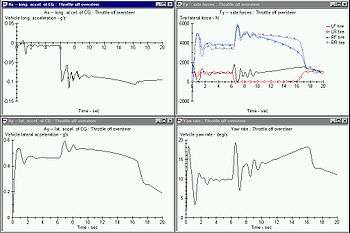Lift-off oversteer
Lift-off oversteer (also known as snap-oversteer, trailing-throttle oversteer, throttle off oversteer, or lift-throttle oversteer) is a form of oversteer in automobiles that occurs while cornering when closing the throttle causes a deceleration, causing the vertical load on the tires to shift from the rear to the front, in a process called Load transfer. This decrease in vertical load on the rear tires causes a decrease in the lateral force they generate, so that their lateral acceleration (into the corner) is also decreased. This causes the vehicle to steer more tightly into the turn, hence oversteering. In other words, easing off the accelerator can cause the rear tires to lose traction, with the potential for the car to leave the road tail first.
Dynamics

The graphs to the right show the simulated effect of lifting off the throttle in the middle of a left turn. The transients in the first couple of seconds are due to the test, in which a step steer input (wheel angle) is applied at 0 s and held constant throughout. The steady state cornering is at constant speed, with a lateral acceleration of 0.45 g approximately until the throttle is released at 6 s.
The yaw rate plot shows the oversteer due to the rear wheels losing traction - after an uncomfortable jerk at 20 deg/s, the vehicle spins sharply in the direction of the turn. The lateral acceleration also spikes to 0.6 g and levels at about 0.55 g, meaning that the radius decreased (i.e., the turn tightened). The side forces on the outside wheels increase and the inside rear (LR) wheel even lifts off the ground, a common occurrence.
Snap oversteer is induced when the throttle is lifted while midway through a corner (lift-off oversteer), often by inexperienced drivers trying to reduce speed after braking too little.
Moment of inertia
Snap oversteer is most common with mid-mounted engine, rear wheel drive (MR) vehicles. Mid-mounted engine vehicles have a much lower rotational inertia than vehicles with a front-mounted or rear-mounted engine. The lower rotational inertia of mid-mounted engine vehicles causes the vehicle to spin much faster than a front or rear mounted engine vehicle. If unexpected, it can catch the driver off guard when cornering, ultimately leading to loss of control of the vehicle.
Recovery
As in all situations where the vehicle experiences loss of rear tire traction on the road surface, the proper maneuver to recover is to turn the steering wheel in the opposite direction of the spin (Countersteering). e.g. If the front of the vehicle is spinning to the left, countersteering to the right will help recover control. More specifically aiming the wheels in the desired direction of travel. In the case of a very violent spin the safest thing to do is turn the wheel so the tires are pointing straight forward with respect to the vehicle. This is often easier to accomplish for inexperienced/panicked drivers.
In popular culture
In the 1940s, the Nazis described the Tatra automobile as the Czech secret weapon due to its treacherous and deadly lift-off oversteer handling characteristics.
Attorney and consumer protection activist Ralph Nader described this type of handling in his 1965 book Unsafe at Any Speed.
Lift-off oversteer is often exploited in motorsport – particularly on loose surfaces (e.g. in rallying) – as a method of cornering faster as, when controlled, it has the effect of turning the nose into the apex and the car slightly sideways which allows early application of power on exiting the corner. Formula One driver Jim Clark's late-braking technique exploited the lift-off oversteer characteristics of mid-engined race cars to attain higher cornering speeds. It became standard competition driving technique as an enhancement of the four wheel drift technique that preceded it.
The 1989-1999 Toyota MR2 (SW20) is notorious for snap oversteer characteristics, after initial liftoff oversteer, when improper steering inputs were made attempting to correct this non-power-on oversteer, the rear of the MR2 would swing one way, then wildly (and quickly) the other.
On April 10, 2010, Consumer Reports magazine rated the 2010 Lexus GX 460 SUV a "Don’t Buy: Safety Risk," as their panel of test engineers determined the vehicle was subject to excessive lift-off oversteer during a standardized evaluation for emergency handling. The test simulates scenarios such as transiting a highway exit ramp while traveling with excessive speed.[1] On April 19, Toyota recalled the GX 460 and the Toyota Land Cruiser Prado for a software update to the electronic stability control to correct the issue.[2]
See also
References
- Consumer Reports (2010-04-13). "Don't Buy: Safety Risk--2010 Lexus GX 460". Cars Blog. Consumers Union. Archived from the original on 2010-04-15. Retrieved 2010-04-14.
- CNN Money https://money.cnn.com/2010/04/19/autos/lexus_gx460_recall/. Retrieved 2016-06-14. Missing or empty
|title=(help)